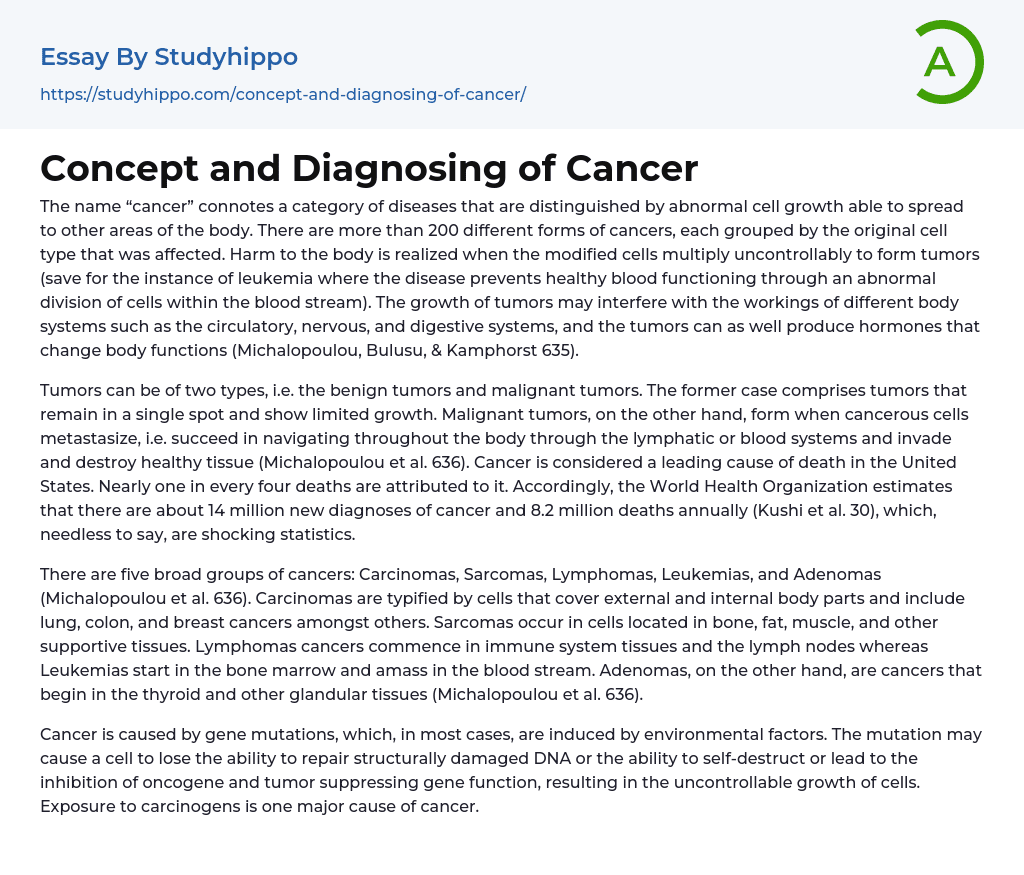Cancer is a group of diseases characterized by abnormal cell growth that can spread to other parts of the body. There are more than 200 different types of cancer, which are classified based on the original affected cell type. The damage occurs when these changed cells multiply uncontrollably and form tumors. However, leukemia is an exception as it disrupts healthy blood function through abnormal cell division in the bloodstream. Tumors have the potential to affect various bodily systems such as circulatory, nervous, and digestive systems. Moreover, tumors can produce hormones that alter body functions (Michalopoulou, Bulusu, & Kamphorst 635). There are two types of tumors: benign and malignant.
According to Michalopoulou et al. (636), tumors are categorized as either benign or malignant. Benign tumors exhibit restricted growth and do not metastasize, whereas malignant tumors involve cancer cells that dissemin
...ate through the lymphatic or blood systems in order to invade healthy tissue.
Cancer is a significant contributor to mortality in the United States, accounting for nearly 25% of all deaths. According to the World Health Organization, approximately 14 million individuals develop new cancer cases annually, resulting in 8.2 million deaths related to cancer (Kushi et al. 30). This alarming statistic cannot be ignored. The five primary types of cancers are Carcinomas, Sarcomas, Lymphomas, Leukemias, and Adenomas (Michalopoulou et al. 636).
Carcinomas, such as lung, colon, and breast cancers, affect cells surrounding external and internal body parts. In contrast, sarcomas occur in cells found in bone, fat, muscle, and other supportive tissues. Lymphomas originate in immune system tissues and lymph nodes while leukemias begin in the bone marrow and build up in the bloodstream. Adenomas are cancers that start
in thyroid and other glandular tissues (Michalopoulou et al., n.d.).
Exposure to carcinogens is the main cause of gene mutations, which are often triggered by environmental factors and serve as the primary instigator of cancer (636). Such mutations can impede cells' DNA repair and self-destruction capabilities, while also impairing oncogenes and tumor-suppressing genes' functions. Consequently, unregulated cell growth occurs.
Carcinogens, such as tobacco, arsenic, asbestos, radiations (like x-rays and gamma rays), the sun, and compounds in vehicle exhaust fumes, are substances that harm DNA structure and can cause cancer. When exposed to these carcinogens, free radicals are produced which damage cells and disrupt their normal functions (Parkin et al. 77).
Inherited genetic predisposition to cancer can also increase the risk of developing it, as these cases involve gene faults or genetic mutations present from birth that raise the likelihood of cancer later in life (Parkin et al. 78). Unhealthy dietary habits, such as consuming high-salt meals, food contaminants, and overeating, can also contribute to cancer. Lack of exercise further enhances cancer risk by negatively affecting body weight and the endocrine and immune systems. Additionally, cancers can develop from infections caused by specific viruses referred to as oncoviruses.
Kushi et al. (31) state that viruses like hepatitis C and hepatitis B, parasites such as liver flukes, and cancer bacteria can all be causes of cancer. The symptoms of cancer differ depending on factors like the disease's location, spread, and tumor size. While skin cancers exhibit noticeable symptoms, pancreatic cancer may not show physical signs until it has advanced significantly (Michalopoulou et al.).
According to Michalopoulou et al. (636), fever, fatigue, anemia, weight loss, and excessive sweating are common signs of cancer.
However, these symptoms alone do not provide a definitive diagnosis for the disease. If cancer spreads to other parts of the body, it can cause swelling in the lymph nodes.
Although there is currently no cure for cancer, certain individuals have successfully overcome various types of cancer (Kushi et al. 37). It is strongly advised to prioritize maintaining a healthy lifestyle in order to prevent and treat all diseases, including cancer. This involves adopting a predominantly plant-based diet in appropriate portions and regularly participating in physical activity (Kushi et al. 45).
This initiative has the potential to greatly decrease the occurrence and dissemination of the disease.
Works Cited
- Kushi, Lawrence, et al. "American Cancer Society Guidelines on Nutrition and Physical Activity for Cancer Prevention: Reducing the Risk of Cancer with Healthy Food Choices." CA: A Cancer Journal for Clinicians 66.1 (2012): 30-67. Print.
- Michalopoulou, Evdokia, Vinay Bulusu, and Jurre Kamphorst. "Metabolic Scavenging by Cancer Cells: When the Going Gets Tough, the Tough Keep Eating." British Journal of Cancer 115.6 (2016): 635-640. Print.
- Parkin, D Max, Lucy Boyd, Sarah C.
According to a study conducted by Darby, David Mesher, Peter Sasieni, and Lesley C. Walker in 2011, titled "The Fraction of Cancer Attributable to Lifestyle and Environmental Factors in the UK in 2010," it was found that certain factors in lifestyle and environment contribute to the development of cancer in the UK.
- Poison essays
- Action Potential essays
- Nervous System essays
- Childbirth essays
- Puberty essays
- Blood essays
- Kidney essays
- Neuron essays
- Body essays
- Glucose essays
- Sense essays
- Heart essays
- Skeleton essays
- Human Physiology essays
- Eye essays
- Immune System essays
- Muscle essays
- Skin essays
- Brain essays
- Central Nervous System essays
- Human Skin Color essays
- Digestive System essays
- Common sense essays
- Respiration essays
- Addiction essays
- Anatomy and Physiology essays
- Biodegradation essays
- Cancer essays
- Dental Care essays
- Disability essays
- Disease essays
- Disorders essays
- Health Care essays
- Infectious Disease essays
- Inquiry essays
- Intelligence Quotient essays
- Lung Cancer essays
- Medicine essays
- Neurology essays
- Nutrition essays
- Olfaction essays
- Physical Exercise essays
- Public Health essays
- Sex essays
- Women's Health essays
- World health organization essays




